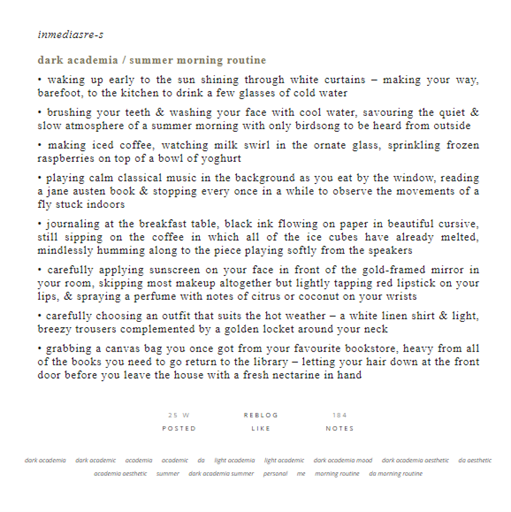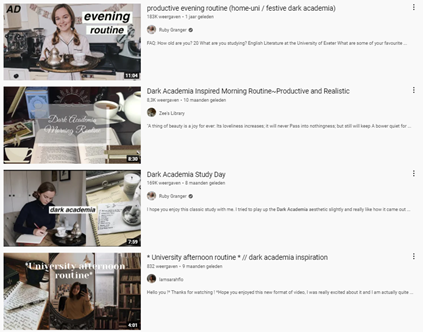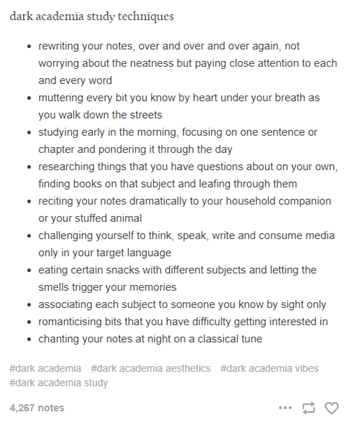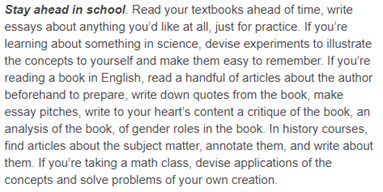
Lifelong learning: the Dark Academia aesthetic as a taste regime
Sharing passions, interests, and cultural tastes with each other is easier than ever thanks to social media. Different movements and subcultures are on the rise, and one that has developed over multiple social media platforms is the Dark Academia aesthetic. In this article, I will explore how Dark Academia can be defined as a taste regime (Arsel & Bean, 2013) and how specific practices relate to the investment in practical knowledge in order to gain capital on social, economic, and cultural levels.
Dark Academia: an academic aesthetic
Dark academia is a popular aesthetic that follows intense and negative themes of academia. It looks at classic literature, art, architecture, and poetry from Western Europe from an academic viewpoint, but with a dark twist. Its visuals are inspired by 19th-century upper-class cultures in Europe, using Gothisicm and American Prep as style inspiration. It is one of several iterations of the academia aesthetic, and while Dark Academia is one of the biggest, there are many others to find. Figure 1 shows an example of Dark Academia against its opposite: light academia. The light academia aesthetic focuses on positive themes and includes colors such as beige and cream, while Dark Academia is performed with colors such as black, brown, and dark green.
Figure 1: Light Academia (above) versus Dark Academia (below)
The Dark Academia aesthetic has made its way through multiple social media platforms. The original hype started around 2015 on Tumblr and has now also made its way on TikTok and Instagram, moving from an intellectually inclined community into a whole lifestyle with its own fashion and practices. It can now be described as a taste regime (Arsel & Bean, 2013): a discursive system that links aesthetics to practice.
From liking to being: taste regimes
Earlier research already established taste as a fundamental mechanism for perpetuating social hierarchies. Bourdieu (1984) argues that taste is not only the possession of social and economic capital but also cultural capital. It is a deeply internalized concept as class-specific tastes are taught and instilled in children to guide them in their social positions. Taste, through class-conditioned habitus (Bourdieu, 1990), is seen as essential in the making of social distinction through everyday practice. However, this long-standing focus on taste and its role in social distinction has ignored the aspects of the practice of taste. Reckwitz (2002) defines practice as a “routinized way in which bodies are moved, objects are handled, subjects are treated, things are described, and the world is understood” (Reckwitz, 2002). This practice involves bodily and mental activities, ‘things’ to use, and background knowledge and understanding. By combining practice theory and theories of taste, Arsel and Bean (2013) delineate the processes that sustain taste regimes through the orchestrating of objects, doings, and meanings. They argue that “practices of taste are circumscribed and perpetuated through socio-historically contextualized discursive systems” (Arsel & Bean, 2013). This complex discursive system is a taste regime.
The Dark Academia aesthetic follows very specific ideas of fashion, décor, and habits
Taste regimes orchestrate visual and material order and offer shared meanings and values for individuals to be a part of this taste regime through the production and reproduction of material representations of an aesthetic domain. The regime shapes the way objects are used, arranged, and chosen in everyday life, and therefore a central aspect of taste regimes is how they are a part of everyday practical knowledge. According to Arsel and Bean (2013), this practical knowledge is established through three separate practices: problematization, ritualization, and instrumentalization. These allow individuals to participate in a taste regime through practice and continuously orchestrate objects, doings, and meanings.
Problematization
The first practice, problematization, refers to how specific objects, doings, and meanings are being questioned by their alignment with a taste regime’s core meanings. They deviate from the normative and cultural standards and therefore become coded as problematic (Arsel & Bean, 2013).
The Dark Academia aesthetic follows very specific ideas of fashion, décor, and habits.
Figure 2: Dark academia activities and clothing
As seen in Figure 2, multiple activities, outfits, and a general color scheme are being promoted. The activities are often related to art, literature, history, and studying. The activities often relate to learning something new, which is a big part of the academia aesthetic in which the focus lies on the love of learning. The clothing is dark-colored and ‘preppy’, inspired by American Prep clothing such as sweater vests, blazers, pleated skirts, and striped ties. The Dark Academia Aesthetics Wiki even mentions specific fabrics like cashmere, wool, and tweed as being a part of the Dark Academia aesthetic. In the figure above, specific zodiac signs are even being associated with a Dark Academia ‘type’.
Next to that, the décor of Dark Academia also makes up a large part of the aesthetic (see Figure 3). Goth architecture aspects such as pointed arches, ribbed vaults, and flying buttresses are often pointed out, and it is no surprise that universities such as Oxford and Cambridge are settings that individuals in Dark Academia dream of.

Figure 3: Google Images results on 'dark academia architecture'
This line-up of clothing and activities in the Dark Academia aesthetic already shows that in order to be a part of the taste regime, you have to adopt a very specific lifestyle. Because of these tight boundaries in practices, there are many objects and doings that do not fit into this taste regime. The tight boundaries have also been criticized by many people online, arguing that it romanticizes an elite scholastic environment and that it is rooted in a Eurocentric privileged tradition. Next to the lack of diversity and elitist nature, it might seem admirable to follow a taste regime that promotes academic prestige and makes studying seem more aesthetically pleasing. But this also puts pressure on individuals to spend their time in very specific ways, not allowing them to, for example, play video games with friends or listen to their favorite pop music. By setting strict boundaries on what fits within the Dark Academia aesthetic, habits and styles outside of these boundaries are immediately problematized.
Ritualization
Secondly, taste regimes establish ritualization by providing individuals with instructions on how to act, both in consuming and in habits (Arsel & Bean, 2013). A ritual can be described as “a type of expressive, symbolic activity constructed of multiple behaviors that occur in a fixed, episode sequence, and that tend to be repeated over time” (Rooks, 1985). These behaviors tend to be scripted and acted out with inner intensity.
We have already seen that Dark Academia offers instructions on practices that are a part of the Dark Academia aesthetic. Next to these general practices such as hobbies and activities, individuals online also share their own Dark Academia daily routines. In Figure 4, a Tumblr user shared a Dark Academia morning routine for the summer. Instead of just being a list of activities, this routine romanticizes the movements, sounds, and touches that are part of it. The goal of these descriptions is to create the image of the perfect Dark Academia routine containing the aesthetic aims of listening to classical music, journaling, and reading classic literature.

Figure 4: A dark academia summer morning routine on on Tumblr
Many of these Dark Academia routines can also be found on YouTube, where content creators often give their viewers a visual of their aesthetic Dark Academia study routine. These videos often show people surrounded by study books, notes, and journals in their environment which follows the gothic inspirations of Dark Academia, such as a university or their own home.

Figure 5: Dark academia YouTube videos
These videos not only provide viewers with an insight into the YouTuber’s life, but they also offer them ideas on their own study routines. Since a big part of Dark Academia is the love of learning and studying, people often share their study routines that others can use in their own academic pursuits. This is not only done through these YouTube videos, but also through lists that contain multiple steps of the studying process, such as the figure below.

Figure 6: Dark academia study techniques on Tumblr
Instrumentalization
The third practice is instrumentalization, which refers to the actualization of meanings through connecting objects and doings. Taste regimes offer recourses that allow individuals to achieve personal goals or achievements, as they frame objects and doings as instruments of change. Material objects are associated with success, and taste regimes suggest to individuals specific ways of doing with objects in order to achieve this (Arsel & Bean, 2013).
Academic performance and development are a large aspect of the Dark Academia lifestyle. As has been mentioned above, Dark Academia exists of hobbies and activities that stimulate learning new things and self-development, together with the main focus and suggestions that are made on aesthetic studying. By reading poetry, going to art museums, and learning a new language, individuals can achieve personal transformations and fulfill their goals. The conscious practice of this lifestyle and its habits is presented as a way to resolve life problems, especially failure in academic instances. By committing to the Dark Academia lifestyle, you commit to being someone who is fashionably studious and always goes out of their way to learn something new.

Figure 7: A dark academia lifestyle tip on academic performance on Tumblr
Even though this might seem ideal from a distance, it also means that materialism and consumption for aesthetics are turned into a mode of goal fulfillment (Arsel & Bean, 2013). It gives objects such as a tweed blazer the power to help someone study and creates a cycle in which individuals can only be successful students if they follow the Dark Academia aesthetic, but are also promised to achieve this success as a consequence of following this aesthetic. Instrumentalization is therefore continuously reinforced through the Dark Academia narrative.
A taste of Dark Academia
Taste is more than the simple ‘liking’ of a specific color, food, or song. Taste regimes give people instructions on how objects, doings, and meanings can help them achieve specific forms of practice and gain social, economic, and cultural capital through their participation. Dark Academia offers people sets of consumption and other lifestyle habits in order to romanticize the life of an excellent participant in academia, allowing people to achieve their goals while being a part of a structured and strict aesthetic. Creating art, reading Jane Austen classics, and sipping coffee in Gothic university buildings are presented as essential for being the ultimate, fashionable academic. The everyday practices of problematization, ritualization, and instrumentalization in Dark Academia allow for the cultivation of practical knowledge through the continuous engagement with objects, doings, and meanings.
References
Arsel, Z. & Bean, J. (2013). Taste regimes and market-mediated practice. Journal of Consumer Research, 39(5), 899–917.
Bourdieau, P. (1990). The Logic of Practice. Stanford, CA: Stanford University Press.
Bourdieu, P. (1984). Distinction: A Social Critique of the Judgement of Taste. Cambridge, MA: Harvard University Press.
Cranz, G. (2004). A New Way of Thinking about Taste. in The Nature of Craft and the Penland Experience (pp. 130-136). Jean McLaughlin, New York: Lark Books.
Molotch, H. (2003). Where Stuff Comes From: How Toasters, Toilets, Cars, Computers, and Many Other Things Come to Be As They Are. New York: Routledge.
Reckwitz, A. (2002). Toward a theory of social practices. European Journal of Social Theory, 5(2), 243–63.
Rook, D.W. (1985). The ritual dimension of consumer behavior. Journal of Consumer Research, 12(3), 251–64.